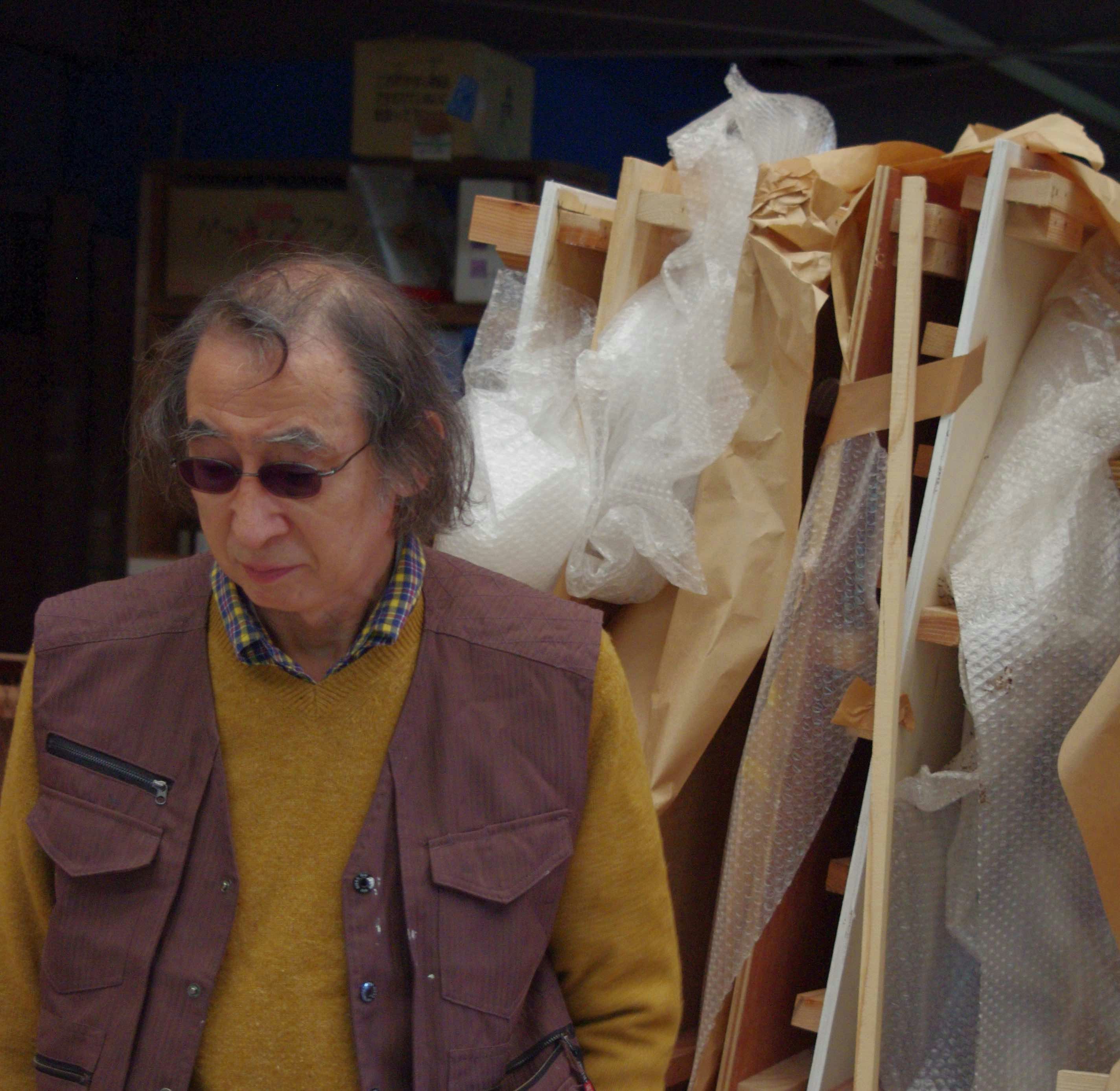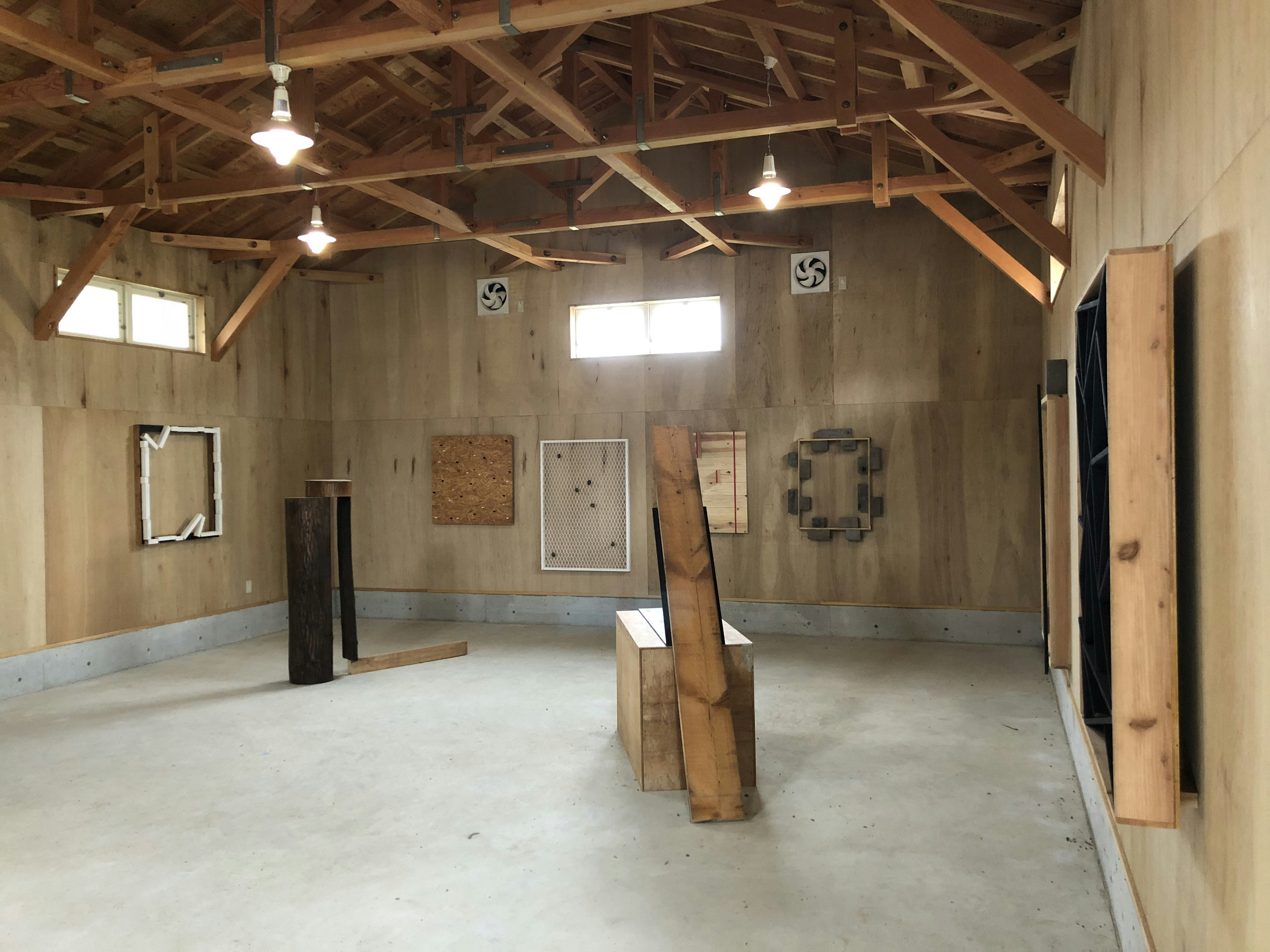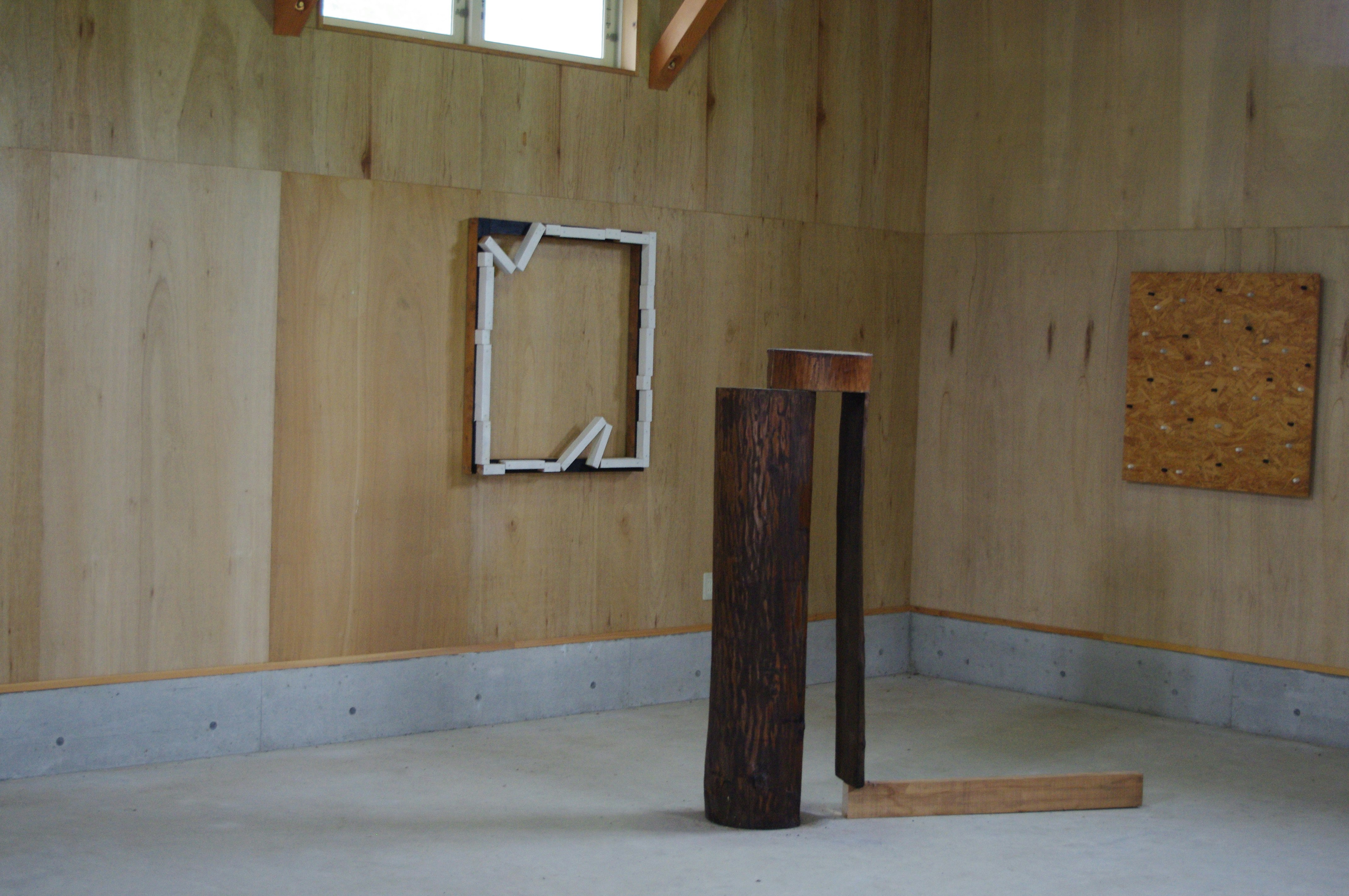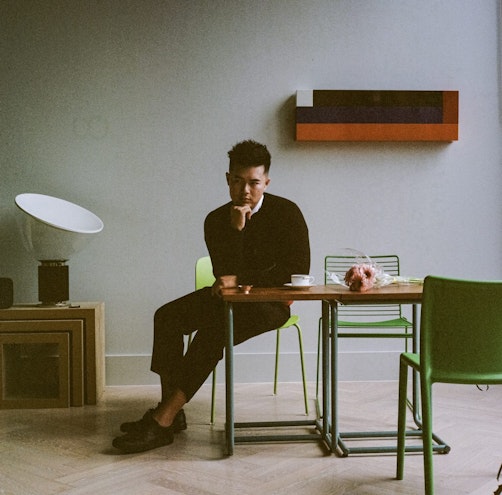An unopened packet of biscuits: a studio visit with Kishio Suga
Micheal Do

Kishio Suga in his studio, April 2018; photo: Haruka Cho
The clockwork precision of Japan’s rail system has always been a source of much personal joy. Even as a typhoon looms during Japan’s humid summer, the 130 km journey south-west from Tokyo to the city of Itō, located on the Izu peninsula in Shizuoka prefecture, is such a pleasure-filled experience. After two train connections, a delicious convenience store bought meal of soy glazed eel on rice, and a podcast about ‘the art of trainspotting,’ down to the minute—precisely one hundred and thirty-seven of them—I find myself where I need to be: in the warehouse studio of famed Japanese artist Kishio Suga.
Kishio Suga, or Suga-san as those in his circle better know him, is a founding member of Mono-ha. Translated roughly into the ‘school of things’, the term is purported to have first appeared in 1973 in art criticism magazine Bijutsu Techo (1). Mono-ha describes the avant-garde Japanese movement of the late 1960s and 1970s characterised by the use of mostly unprocessed materials—commonly wood, concrete, rocks and metal—that are casually choreographed into juxtaposition so that they spark new reflections upon the object, providing a basis to see the world afresh. As we sit in Suga-san’s studio, I offer him two packets of Rose Street Bakery Anzac biscuits, figuring it would be a nice antipodean offering. Naturally, we begin conversation about the origins of Mono-ha. Softly spoken, wearing a Mustard-coloured jumper (I’m told yellow is his favourite colour), he tells me that Mono-ha at the time was never the name of a specific group or movement per se, but rather a label applied to several artists active in Tokyo in the era. In fact, the artists categorised under this umbrella, including Nobuo Sekine, Lee Ufan and Jiro Takamatsu, had little understanding that they had even formed a movement (2).
The origins of Mono-ha to this day remain elusive in that no one in the group has claimed to coin the term. ‘Back then, there were lots of Japanese artists doing radical experiments. For us, it was about the perception of things and existence,’ Suga-san recalls. I probe a little deeper, asking him about the Eastern concepts of Shintoism and animism so present in Japanese culture and he responds, ‘Japanese people have a deeper awareness and understanding of objects. Humans, objects and things exist all in the same plane. The year after I finished university, I studied Eastern philosophies, particularly scholars from India.’ Suga-san has been deeply inspired by the philosopher and religious teacher Nāgārjuna (c. 150–c. 250 CE) (3). Considered to be a founder of Madhyamaka Buddhism, Nāgārjuna is credited with developing notions of emptiness and ideas about ‘mutual interdependence between various phenomena’ found within this school of Buddhism. ‘Without this foundation, I would have never come to appreciate the materials in my work,’ confesses Suga-san. It is from this philosophical and spiritual basis that Suga-san’s practice explores relationships between objects, humans and things.

Kishio Suga in his studio, April 2018; photo: Micheal Do.
During the 1960s and 1970s, Japan experienced radical shifts in ideologies, systems of power and hierarchies. Labeled as fukakujitsusei no jidai, or ‘the age of uncertainty’, the period was marked by protests, political scandals, social upheaval and a greater understanding of how people within certain strata of society were effectively shut out of societal participation and decision-making. Students in 1968 protested over the 24 billion yen embezzled from the university system. There was much public anguish over the government’s decision to renew the Treaty of Mutual Cooperation and Security between Japan and the USA that affirmed the latter’s right to influence Japan’s internal and foreign policy. Japan also experienced great economic fallout from the decision of the Organisation of Petroleum Exporting Countries to halt petroleum exports to Israeli allies during the course of the 1973 Arab–Israeli War. Suga-san reminds me that artists of that time were plugged into this climate of discontentment. It would be these disruptive events and societal forces that served as a basis for the artists within the avant-garde to experiment and respond to the turbulence around them.
Writing in the ‘70s, Suga-san highlighted the importance of allowing an artwork ‘to act on its own’ (4). In Bijutsu Techo, Suga-san published Existence Beyond Condition (1970), where he wrote that the value of art is more than the sum of artistic labour invested in it—an idea he was taught during his time at art school (5). By ‘shedding all subconscious intent or idea of making things … [one could eliminate] ‘the sadistic tendency to turn a thing into something unique by making it over anew by imposing a sense of being on its structural organisation’ (6). He would expand on this idea in his 1971 essay Left Alone as situation:
The first step is to stop ‘placing’ and ‘presenting,’ as is common practice in the display of artworks. Instead, we have to ‘leave things alone.’ Leaving things alone need not entail scattering whatever is actually visible…. What I mean by ‘left alone’ … seeks to remove any idea of things (mono) and situation from existing systems of art… Sometimes, things (mono) speak more eloquently, and so much more imaginatively than humans, that the imagination the things themselves possess must first be smashed. Consequently, I have no choice but to leave things and their situation alone. (7)
The adherence to this principle is self-evident when one enters his studio of twenty years. Founded on an industrial estate, his studio is fecund with materials: slinky pieces of plywood, an impressive collection of tools and pots of paint purchased from the nearby hardware store, bits of rubber and bits and pieces of nature collected on his daily travels. Here, his humble materials are left until he’s ready to forms them into artworks. Suga-san tells me a little about his work ethic, describing himself as a white-collar worker. Every day, he commutes from his home to his studio, working from morning until evening with regimented breaks throughout the day. ‘I’m most productive when I’m lying in bed. I can conceptualise an artwork in my mind. When I get to the studio, I find the materials that I need and make it.’ I tell him that I often have my best ideas in the shower, to which he chortles, ‘Yes, everyone has their own rhythms. I enjoy my time the most when I can just focus on my art-marking, especially on my daily walks. I always take memos so I don’t forget my ideas, I tend to have at least one good idea a day.’ At seventy-four years of age, Suga-san looks forward most to going for walks in nature. This is the reason why the artist moved to Itō, famed for its natural hot springs, most of which exists as the Fuji-Hakone-Izu National Park. Of the area Suga-san has said, ‘I’m inspired by all kinds of things: trees, stones, rocks, grasslands, wastelands, the sky, or the movement of the wind. When I look at them, I think about the interconnected spaces between them, their conditions and the nature of their existence’ (8).

Kishio Suga’s studio, April 2018; photo: Micheal Do.
In the documented conversations of the Mono-ha artists in the 1970s they often spoke about how their use of materials offered them a sensual immediacy that made them ‘feel numb’, gave them ‘chills’ or ‘palpitations’ (9). I ask Suga-san about the overall audience impressions of his work more generally and he offers an interesting anecdote from 1973 where he exhibited at the 8th Paris Youth Biennale held at the Musee d’Art Moderne de la Ville de Paris. ‘It was very conservative. They didn’t think my works were art.’ In reference to the outdoor installation of his artworks he noted, ‘people stood and climbed on my work. They regarded them as raw materials and couldn’t see beyond that.’
However, this view could not be further from contemporary art world understandings of Suga-san’s work. Over the past ten years, there has been significant reevaluation and recontextualisation of the Mono-ha movement, anchoring this strand of Japanese Modernism against global European movements of the time such as land/Earth art, Minimalism and Arte Povera (10). This reassessment began with the 1995 exhibition Asiana: Contemporary Art from the Far East, a large-scale survey held at Palazzo Vendramin Calergi in Venice that brought together over 25 recreated artworks by the 10 original founding members (11). More recently, this enthusiasm spread to the U.S. which saw the strangeness and wonder of the movement explored in the 2012 exhibition Requiem for the Sum: The Art of Mono-ha organised by Blum & Poe. The exhibition included 63 examples of the most iconic aspects of the movement, including Nobuo Sekine’s Phase–Mother Earth (1968), a cylinder of compressed dirt and concrete that sat beside the hole from which the dirt had been excavated from. According to art historian Joan Kee, the work’s original enactment is said to have triggered the formation of the movement (12). Suga-san offers a confident nod as he tells me of the increasing worldwide recognition of the movement. ‘They don’t deny it anymore. It only took forty years,’ he says drolly. After a moment, he wryly adds, ‘No time at all.’
Following the gradual dispersal of Mono-ha’s original members by 1972, Suga-san continued to develop his vision. Based on core tenants and philosophies of the movement, Suga-san’s practice is particularly concerned with the interactions between materials and their surroundings with a focus on generating what the artist called jokyo, or situations. Japanese art critic and writer Matsui Midori notes Suga-san’s uncanny ability to ‘emphasise the relationship between objects and surrounding space’ that foreground details, colours and textures that evoke specific memories and cultural experiences to Suga-san’s native Japan (13). Nowhere is this more apparent than in Suga-san’s newly built gallery space opposite his storeroom and studio. Featuring plywood walls and concrete floors, the space resembles something of a walk-in Suga-san-designed hinterland that exists between the real, imagined and invented. He lets me explore the space without offering much of his own commentary. Each situation feels like a carefully laid-out story that can be consulted piece-by-piece, artwork-by-artwork, forming a greater whole. Two and three dimensionalities have been inventively collapsed in about painting-sculptures comprising of organic and industrial elements. Curvaceous steel braches are precariously balanced upright, set in dialogue with wall-mounted plywood structures that include other appendages hewn together, allowing for the materiality of the sculptures to speak first and fore mostly. His materials may be humble, but the execution is grand.

Kishio Suga’s studio, April 2018; photo: Haruka Cho.
As we take a seat back in his studio I notice that the Anzac biscuits remain unopened. Feeling a pang of hunger but figuring it would be impolite to suggest opening them, I continue with more reflective line of questioning. I ask him whether his views on art-making have changed over his 48-year career. He pauses for thought then responds, ‘Basically, my understandings haven’t changed. Maybe the way I see things have changed but my ideas have not … There are several levels to understand my works. They are very closely related but when someone looks at the works, they have their own interpretations.’ It is at this point that Suga-san tells me about the importance of these constructed situations as a centripetal force that bonds the viewer, artist and artworks together. I ask him about the audience and collaboration to which he nods purposely as he pours me another glass of water. ‘I try to create some art that is not understandable. Artists use their minds and that’s why I want the audience to also use their minds.’ And with that he swallows a large gulp of water.
We move onto the subject of time. ‘Everything changes, sometimes these are imperceptible and intangible; it might take a few years for these changes to appear. But then sometimes, time causes an artwork to collapse. This is okay too.’ He pauses for thought and begins again, ‘Yes, everything at some point must return to its original state. Back to zero. Actually … I’ve always had this idea …’ Suga-san smiles and lets out a knowing laugh, knowing better perhaps than to share an idea that he is still working on. Realising that we are now close to two hours into our conversation, Suga-san apologies and excuses himself. He is due at the dentist later that day.
Suga-san offers me a warm hug and several photo opportunities as we say our goodbyes. After finding our taxi that struggled to locate us in the area’s industrial labyrinth, we make our way back to Itō’s train station. And true to the precision of the Japanese transit system it takes precisely one hundred and thirty-nine minutes later, two more than what was required to get here, to arrive at Tokyo station. Over another round of soy glazed eel at one of the station’s many eateries, I quietly contemplate Suga-san’s words that some things are better left alone, Anzac biscuits and all.

Micheal Do and Kishio Suga, April 2018; photo: Haruka Cho.
Acknowledgements
I’d like to thank Haruka Cho for her assistance in interpreting my conversation with Suga-san and getting me from point A to point B with such ease. I’d also like to extend my thanks to Mr Tomio Koyama and his gallery staff for facilitating this incredible meeting. My warmest thanks to the National Association for the Visual Arts and The Freedman Foundation for awarding me their generous Freedman Foundation Travelling Scholarship for Curators, which allowed me to travel East Asia and undertake incredible meetings and studios visits. This article would not be possible without their support.
Notes
(1) Interestingly, the Japanese term mono is multivalent and lacks an English equivalent. It can be understood as ‘thing’, ‘matter’, ‘material’ and ‘object’.
(2) Akira Tatehata, ‘Mono-ha and Japan’s Crisis of the Modern’, Third Text 16:3 (2002) 223–236.
(3) Mami Kataoka, ‘Probing situations’ in Kishio Suga: Expanded Self-Space | Divided Orientation of Space (Tokyo: Tomio Koyama Gallery, 2018).
(4) Joan Kee, ‘Points, lines, encounters: the world according to Lee Ufan,’ Oxford Art Journal 31:3 (2008) 403–424 [accessed 1 November 2018].
(5) Tatehata.
(6) ibid.
(7) ibid.
(8) As quoted in ‘Reflections: Kishio Suga’, trans. Ashley Rawlings, ArtAsiaPacific Almanac XI (2016).
(9) Tatehata. These words often appeared in panel discussions held by the founding members Koshimizu, Sekine, Suga, Narita Katsuhiko and Lee, and published under the title ‘A world revealed by Mono’ in Bijutsu Techo.
(10) Kataoka.
(11) Tatehata.
(12) Joan Kee, ‘Requiem for the sun: the art of Mono-ha,’ Artforum International 50:9 (2012).
(13) Matsui Midori, ‘The presence of things, the position of people: the interdependence of mind and matter in Kishio Suga’s artistic practice’ in International Scenic Space (Tokyo: Tomio Koyama Gallery, 2015).
About the contributor
Micheal Do is a curator, programmer and writer working across Australia, New Zealand and Asia. His curatorial focus lies in developing thematic and immersive exhibitions that extrapolate research and artistic practices into contemporary contexts.
